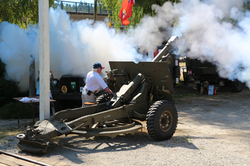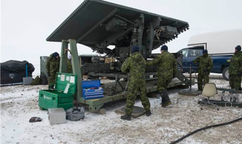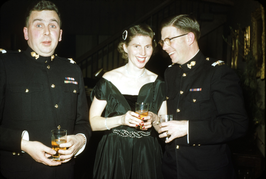|
Newsletter on line. This newsletter, and previous editions, are available on the RUSI Vancouver website at: http://www.rusivancouver.ca/newsletter.html Wednesday Lunches The 15 Field Officers Mess holds weekly lunches, serving a 5 course, ‘homemade’ meal for only $15- you won’t find a better meal - or a better deal, anywhere. If you are in the area on a Wednesday, drop in and join us for lunch. The dress for Wednesday lunches is suit/blazer/sports jacket and tie. Dress for ladies is the equivalent. Your guests are always welcome but don’t forget to tell them about dress requirements BEFORE they come. World War 2 - 1940 John Thompson Strategic analyst quotes from his book “Spirit Over Steel” July 22nd: The Special Operations Executive (SOE) is formed to “set Europe ablaze”. The Havana Conference begins – the aim is to keep the Axis out of the Americas. July 23rd: The British Purchasing Commission in US reaches agreement that will allow the UK to buy up to 40% of US Aircraft pro “production. A Czech provisional government in exile forms in London. July 24th: After two weeks of sparring in the Channel over attacks on convoys, the RAF is missing 48 aircraft and the Luftwaffe has lost 93 (but losses in fighter planes are roughly equal). Fighter Command refused to be drawn into major battles, and has used this time to frantically build its strength. July 25th: The US prohibits all sales of oil and metal products to all countries outside of the Americas and Britain except under License. A series of fierce attacks by the Luftwaffe on Channel shipping begins, the intent is to draw out RAF (unsuccessfully) but 11 of 21 ships from a single convoy are sunk near Dover. July 26th: Japan decides to get more aggressive in Indochina in order to cut off China’s supply sources. The Admiralty forbids further shipping past the Straits of Dover in daylight. July 27th: The Luftwaffe sinks two RN destroyers off Dover. July 28th: The German auxiliary cruiser Thor sends the RN armed Merchant cruiser Alcantara fleeing; it takes a real cruiser to sink these German commerce raiders. After another destroyer is sunk off Dover, the remaining force is pulled to Portsmouth and it is decided to keep surface units out of the east end of the Channel unless the German invasion actually begins.  Bob Mugford trips the firing lever to fire the first round on July 1, 2015.The last time this gun fired was over 50 years ago. Bob Mugford trips the firing lever to fire the first round on July 1, 2015.The last time this gun fired was over 50 years ago. First Shot for Our 25pdr For the last year, a few dedicated volunteers from the Museum, Association and Regiment, with financial asstance from the Society, have been working to put our gun in firing order (for blanks only, of course). We successfully fired our first blank round at the Canada Day ceremony in Port Moody. A 1 lb charge of black powder gave us a good bang and set off a car alarm across the street. The next step is to train some of our members in 25pdr gun drill so thay can form a detachment to deploy, load and fire the gun using proper proceedures and in approprate uniforms.  A military mobile radar unit in Resolute Bay, Nunavut. The government is terminating its contract with Thales Canada Ltd., which was to supply new radar units to support CF-18 fighter jet squadrons A military mobile radar unit in Resolute Bay, Nunavut. The government is terminating its contract with Thales Canada Ltd., which was to supply new radar units to support CF-18 fighter jet squadrons CF18 Bases Won’t Have Radar Units Replaced Public Works abruptly ends procurement $55M deal after delays and cost problems By Dean Beeby, CBC News Jul 12, 2015 Another multimillion-dollar military purchase has gone off the rails. The Harper government is terminating its contract with Thales Canada Ltd, which was to supply new radar units to support Canada's CF-18 fighter jet squadrons in Cold Lake, Alta., and Bagotville, Que. The deal signed in November 2010 was initially worth $55 million for two tactical-control radar systems, with delivery to begin in 2013. Thales won the tender over one other bidder. Defence Department documents show costs had risen to more than $78 million by 2013. And by November last year, the Public Works Department was deep in negotiations with Thales to resolve problems. "In February 2015, Canada and Thales reached agreement in principle to terminate this contract by mutual consent," said Public Works spokeswoman Annie Trepanier. Negotiations for a final termination agreement are still underway, and Public Works declined to provide any information about penalties, losses to the taxpayer or even the reason for the termination. "Public Works is working with DND to identify an appropriate path forward to meet their long-term capability needs on this project," Trepanier said in a terse email. National Defence documents indicate the military had spent at least $6.5 million on the doomed project by 2013. The botched deal is yet another military procurement gone sour, alongside the more high-profile F-35 Stealth Fighter project, the Cyclone helicopter purchase to replace the aging Sea Kings, and used British submarines that have been sinkholes for maintenance and repair dollars. The deal for two Ground Master 400 air-defence radars, a product launched by Thales in 2008, was to replace existing equipment acquired in 1991. "Our government's investments are helping to ensure that our airmen and women have up-to-date equipment and infrastructure needed to perform their missions," Peter MacKay, then defence minister, said in early 2011 when announcing the deal. MacKay said first deliveries were expected by February 2013, and that 40 jobs would be supported until final deliveries in September this year. The France-based parent of Thales Canada, Thales Group, said its Ground Master 400 systems have been sold to Germany, Finland and Malaysia, among others. Canada's existing tactical radar systems are designed to be mobile, and have been deployed to Germany in 2000, Florida in 2008, and to Resolute Bay, Nunavut, in May this year, among other locations. Most of the time, they support NORAD fighter-jet training at their home bases by providing a comprehensive picture of the skies up to 450 kilometres away. David Perry, an expert in military procurement, said it's not clear whether smaller deals like the radar project are as beset with problems as high-cost contracts. Departments are required to report regularly to Parliament only on major Crown projects worth more than $100 million, which means smaller projects can escape proper scrutiny. "We tend to place a lot of the focus on the big projects.… Is it only the big ones that have been problematic or are they just the only ones you ever hear about?" said Perry, a senior analyst with the Ottawa-based Canadian Global Affairs Institute. Perry said he plans a project beginning next month to examine all military procurement contracts, big and small, to correct for any bias that results from the $100-million reporting requirement. Public Works issued a notice to the defence industry in early 2008, calling for letters of interest to replace the existing Westinghouse AN/TPS-70 radar systems, saying they were "past their life expectancy [and] are no longer supportable." But National Defence spokesman Maj. James Simiana said the existing systems "are operational and they are still capable of supporting both Bagotville and Cold Lake." Siegfried Usal, an Ottawa spokesman for Thales Canada, confirmed there's an agreement in principle with Public Works to terminate the project. "No final resolution has been negotiated yet, therefore Thales will not comment further on this," Usal said in an email. DoD, UK Defense Ministry Sign Reserve Forces Memorandum WASHINGTON, July 27, 2015 The US Defense Department and the United Kingdom's Defense Ministry signed a memorandum of understanding today that officials say signifies expanding international relationships while serving a valuable role in security cooperation. Maj Gen John Crackett of the British army, assistant chief of the defense staff for reserves and cadets, and Paul D Patrick, deputy assistant secretary of defense for reserve readiness, training and mobilization, signed the Military Reserve Exchange Program memorandum. "This memorandum of understanding between the US and United Kingdom provides ongoing proof of our continued dedication to our long-standing international relationships," Patrick said. "The Foreign Resident Program strengthens the partnership between our two nations and plays a key role in maintaining individual readiness of reservists and their contribution to national defense." The signing ceremony formalizes a unique agreement between the two nations to allow reservists residing overseas to train with a host-nation unit. Training this way allows reservists to stay engaged and meet their service commitments while opening up opportunities they may have not had in the past, officials said. "This is the first arrangement of its kind," Patrick said. "It demonstrates commitment to our people and their employers by providing more flexibility to meet their requirements and offers unique training opportunities." In addition, the ceremony recognized the 30th anniversary of the countries' Military Reserve Exchange Program. Since the program's memorandum of understanding was signed in 1985, almost 3,000 reservists from both nations have participated in the program. Maj Gen Richard Cripwell of the British army, defense attaché and head of the British Defense Staff in the United States, presided over the event.  The General Dynamics Mission Systems Canada and Colt Canada system are outfitted on a rifle. – Photo by David Pugliese The General Dynamics Mission Systems Canada and Colt Canada system are outfitted on a rifle. – Photo by David Pugliese Defence Firm Wants Smartphones on the Battlefield David Pugliese, Ottawa Citizen July 20, 2015 One of the country’s top military companies wants to convince the Canadian Army that putting smartphones on the battlefield is the way of the future. The army hopes to improve communications between troops through a $300-million initiative called the Integrated Soldier System Project, or ISSP. That would provide equipment not only to allow troops to track each other as they move throughout the battlefield, but feed communications and targeting information into their helmets or data devices they could carry. The Conservative government will soon announce the winner of the first $7-million phase of ISSP as part of its defence-related announcements in the run-up to the federal election. The other ISSP phases are still years away. Officials with General Dynamics Mission Systems Canada, a company with facilities in Ottawa and Calgary, say the firm is already at the level of technology that ISSP hopes to introduce in the future. Instead of cumbersome and expensive military radios and other data devices, General Dynamics has made use of smartphone technology. It has produced militarized versions of the civilian devices and the support system needed for them. “You can pump videos to it, you can take pictures, transmit those pictures, chat, all those types of things you do on your smartphone, but now it’s on the battlefield,” said Rick Fawcett, director of business development for General Dynamics Mission Systems Canada in Ottawa. The company has also successfully linked smartphones into existing military radio equipment. Insurgents in Afghanistan, Syria and Iraq have used cellphones during combat. But western militaries have shied away from such technology because it can be jammed and relies on civilian networks. To deal with those problems, General Dynamics is working on a portable cell network for militaries, as well as systems that can’t be jammed, Fawcett said. Colt Canada, in co-operation with General Dynamics, has also integrated smartphones and other information sources onto its rifles and grenade launchers. In addition, Colt, of Kitchener, Ont., has linked a small drone to its weapons, allowing soldiers with smartphones to not only view what their colleagues are seeing on the battlefield, but also what the cameras on the pilotless aircraft are monitoring. Colt’s technology also includes a global positioning system and navigation capability, so the rifle’s geographic position and pointing angles are known and communicated to other soldiers. “We’re taking the rifle from being a Spitfire to being a CF-18 fighter,” said Warren Downing of Colt Canada. Colt Canada has already attracted interest in its system, selling several to the US Marines. Other US government agencies and Special Forces units have also attended demonstrations of the equipment. The advantages of smartphone technology are evident, Fawcett noted. The devices are readily available, off-the-shelf technology that, with the installation of a $49 hardened case, can be made ready for rough handling by soldiers. There is no need for extensive training as troops, just like most members of the public, already know how to use smartphones. Then there is the technology support. “There was a day when military research led communications but those days are long gone,” Fawcett explained. “Look at what Samsung or Apple invest in their devices. No military can match that type of investment.” General Dynamics decided against bidding on the first phase of the Canadian military’s Integrated Soldier System Project. Instead it directed the $1 million that would have been spent to compile a bid into further research. “Our strategy is to show the army that we are beyond today what the ISSP project hopes to do in the future,” Fawcett noted. He said General Dynamics will now focus on improving technology designed to prevent smartphones from being jammed, as well as improving interfaces with older army radio technology still in use. The firm will also move forward on a portable military cell network that can be set up in remote areas, whether in the Canadian north or African desert. The US military is pushing ahead with a program to use smartphones on the battlefield. Britain is also looking at a similar concept. Fawcett believes the drive for change in Canada will come from the army itself. It has already sponsored demonstrations of the capability. And soldiers use smartphones in their daily lives. “When you talk to soldiers, they don’t understand why a hand-held radio has to weigh five pounds,” said Fawcett. “We’re seeing more traction (for the idea).”  Hacking's Next Frontier: Cars Hackers seize control of Jeep, then crash it, using a laptop and cellphone about 15 km away BY THE TELEGRAPH JULY 23, 2015 Hackers have managed to take control of a car and crash it into a ditch while sitting on their sofa about 15 kilometres away. In the first such breach of its kind, security experts caused the engine to cut out and applied the brakes on a Jeep Cherokee, sending it into a spin. The U.S. hackers said they used just a laptop and cellphone to access the vehicle’s on-board systems via its wireless Internet connection. They claim that more than 470,000 cars made by Fiat Chrysler could be at risk. The hack was revealed by security researchers Charlie Miller, a former staffer at the National Security Agency, and Chris Valasek. They worked with Andy Greenberg, a writer with tech website Wired.com, who was driving the Jeep on public roads in St. Louis. In a demonstration for The Washington Post, Miller had to start the car the old-fashioned way, with his Jeep key fob. But once it was running, he found the vehicle’s Internet address and, while sitting in his office and typing on a MacBook Pro, hacked in through the dashboard information and entertainment system. As Greenberg drove in a parking lot nearby, Miller changed the radio station and turned up the volume. He locked and unlocked the doors, and shot wiper fluid onto the windshield as the wiper blades swooped back and forth. Then it got more serious. Miller, still on his MacBook almost two kilometres away, shut off the engine. He briefly disabled the brakes. Then, he caused the transmission to malfunction, which led the Jeep to lose speed even when the gas pedal was pressed repeatedly. While the car was moving slowly in reverse, Miller even turned the steering wheel, causing the Jeep to carve a wide circle through the lot. Miller said the purpose was to prompt urgency from automakers. “I don’t want to want to wait until there are cars crashing on the news every month,” he said. Miller and Valasek previewed their research for Chrysler, allowing it time to prepare a software update. Dealerships can install the new software, or customers can download it onto a memory stick and insert it into their vehicles. Fiat Chrysler Automobiles issued a sharply worded statement as news of the hack broke. “Under no circumstances does FCA condone or believe it’s appropriate to disclose ‘how-to information’ that would potentially encourage, or help enable hackers to gain unauthorized and unlawful access to vehicle systems,” it said. ‘They really just patched one vulnerability. But they didn’t fix the systemic issues’. It also offered reassurances to drivers. “The company monitors and tests the information systems of all of its products to identify and eliminate vulnerabilities in the ordinary course of business.” Can motorists relax now? Miller and Valasek don’t think so. “They really just patched one vulnerability. But they didn’t fix the systemic issues,” said Valasek, director of vehicle security research for IOActive, a security company.  Who is it? Last Week: This picture was taken at the Officers Mess New Year’s Eve party in 1961. LCol Bud Garrett, to the right of the carver, was CO of the Regiment from 1959 to 1962, next to him is the Wines Officer, then Lt Bailey, later CO from 1972 to 73 and on the far left is the PMC, Maj Eckford. Next to Maj Eckford is Mike Maskovic and his brother Don. They joined the Regiment in 1960. At that time they had their own little tailoring business on the side and were the two best dressed gunners on parade, having re-tailored their issued battledress. Several others in the Regiment, when they saw the results, had them alter their uniforms r for a better fit as well, for a modest fee. They catered a number of the Regiment’s activities in those years. Don eventually took over as Officers Mess bartender and with his wife Jean, catered to Regimental functions until the late 80s. All have since passed away, except for Mike Maskovic and Gary Bailey. The carver was a chef who had been brought in just for this event. No one knows who he is.  This Week: Well, it appears that only one person noticed my gaff last week, so….hmmm. In the words of my hero, Capt. Mainwaring (of “Dad’s Army”), “I was wondering when you’d notice that.” Enough said. This week’s original, never used before photo is of happy mess life. Just which mess it is cannot be determined due to the darkness of the background, but it is certainly an artillery mess, and most likely that of 15th Field (although 43rd HAA had one in North Vancouver, and 102nd Coast must have used the one at Jericho, where they were stationed). The time is most likely the 1950s, given that the original slide is seemingly of that vintage, and the dress of the young lady harkens back to that era of tail fins and tight waists (until the “sack dress” came along). Another hint is that the two young officer cadets both have WWII ribbons, with the chap on the left having served overseas. So, that brings us to our question of the week: who are these happy messmates and date? Do any of you know who they are? Maybe one of them later became CDS, or your mum or dad. Let us know by contacting the too-young-to-remember editor, or the author, John Redmond ([email protected]). Thanks in advance. From the ‘Punitentary’
An incompetent naval captain: He grounds the warship he walks on. Murphy’s other Laws Reports are written in one of four tenses – past tense, present tense, future tense and pretense. Quotable Quotes A hero is no braver than an ordinary man, but he is braver five minutes longer. - Ralph Waldo Emerson |
Archives
June 2024
|



 RSS Feed
RSS Feed